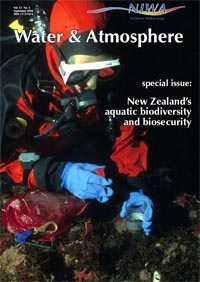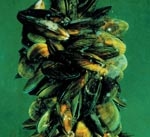PDF of this article (215 KB)

Geoff Read Sean Handley
An invasive worm makes for trouble, not pearls, inside a prized shellfish.



New Zealand mussels were thought to have few harmful animal parasites, so it came as an unwelcome surprise when worm-inhabited blisters were found inside the shells of farmed green-lipped mussels in mid-2003. Green-lipped mussels (Perna canaliculus) can be colonised by some native shell-borer worms, but until last year no outbreaks of severe shell defects induced by these worms were known. It had seemed that the hard mussel shell with its shiny protective covering (or periostracum) was rather difficult for most worm species to attack, and in any case not an ideal home for them because it is comparatively thin.
When NIWA scientists investigated the problem blisters in mussels from marine farms in the Firth of Thames along the Coromandel Peninsula, they found that the polychaete mudworm Polydora haswelli was triggering the shell malformations. P. haswelli is a blister-inducing shell-borer worm, first described from Australia, and a new invasive alien polychaete for New Zealand. It was recently discovered in the northern North Island in scallops and oysters. At least some of its previous occurrences were overlooked because of its morphological similarity to Polydora websteri, another pest mudworm which also occurs in New Zealand, mostly inhabiting Pacific oysters. Live specimens of P. haswelli can be readily distinguished from P. websteri by its distinctive anterior dorsal pattern of black pigmentation and the black bands on its feeding tentacles; both features are lacking in the better-known P. websteri.
How the damage is done
Normally, members of this group of worms tunnel fairly harmlessly lengthways inside shells. In contrast, the P. haswelli were drilling perpendicularly straight through the green-lipped mussels, and intruding into the space between the shell lining and the living mussel. In response the mussels sealed off the worms under a thin overlay of organic material with a further calcareous shell layer on top. The fragile internal chambers thus formed were either long, low blisters extending into the shell peak (umbo) or less-extensive, but more projecting, nodule-like blisters.
The affected mussels were of harvestable size at about 80 mm long, and had blisters up to 60 mm long. Some of the blister cavities were up to 7 mm deep, but most were not much over 1 mm deep. Within this cavity, a P. haswelli worm occupied a U-shaped track surrounded by a firm brown “mudpack” of fine debris. A figure-eight or B-shaped pair of adjoining holes usually indicated the worm entrance. The contents of cavities abandoned by worms could be blackened and anaerobic.
A feature of this particular event was that the P. haswelli strongly favoured settlement on the mussels’ more severe growth-check lines. These are low ridges or steps that can form in the shell when mussel growth is disturbed by transferring them to new ropes on the farm longlines. Viewed close-up, the growth checks range from small overlapped gaps in the periostracum to distinct steps in the shell profile. They appear to provide a crevice or ledge on which larval worms can settle more readily than on the normal very smooth shell surface. While some worms were settling away from growth checks on the mussels, it seems probable that minimising growth checks would reduce infestations.
Why are shell blisters in mussels of concern? If the worm is soon sealed-off how can it affect the health of the mussel? Unfortunately this is not the issue. While it is probable the energy cost to the mussel of walling off this little worm intruder is not very important, the end result is an obviously flawed shell. This is going to be repellent to an end consumer, and in any case contamination of mussel flesh from the muddy or unpleasant anaerobic contents of broken blisters is not acceptable. Badly blistered mussels are not suitable for processing.
Help stop the spread
Polydora haswelli has probably not been in New Zealand very long. It was first recorded in oysters in Mahurangi Harbour in 1996 and first noticed in abundance in the Firth of Thames by scallop harvesters in 1999. How did it breach our biosecurity? Perhaps planktonic larvae were discharged into the Hauraki Gulf in ship ballast water. Now it is well established and we must learn more about it in order to reduce the damage it could do in shellfish farms. We know the worm occurs at least as far north as Whangarei Harbour; so far it seems it has not yet reached the major aquaculture areas in the Nelson/Marlborough districts. Therefore, we advise against transferring northern mussels and oysters to the south for on-growing or as broodstock if the shells are large enough to have P. haswelli borings. Any suspected occurrences of P. haswelli outside its known distribution should be reported to NIWA.
The authors would like to hear from anyone who finds Polydora haswelli south of the Coromandel.
You can contact Geoff at 04 386 0300 ( [email protected] ) or Sean at 03 548 1715 ( [email protected] ).
Learn more about polychaetes in the Guide to New Zealand Shell Polychaetes.
Geoff Read is based at NIWA in Wellington and Sean Handley is at NIWA in Nelson.
Teachers’ resource for NCEA AS: Biology 2.6, 2.9; Science 2.2. See other curriculum connections at www.niwa.co.nz/pubs/wa/resources
